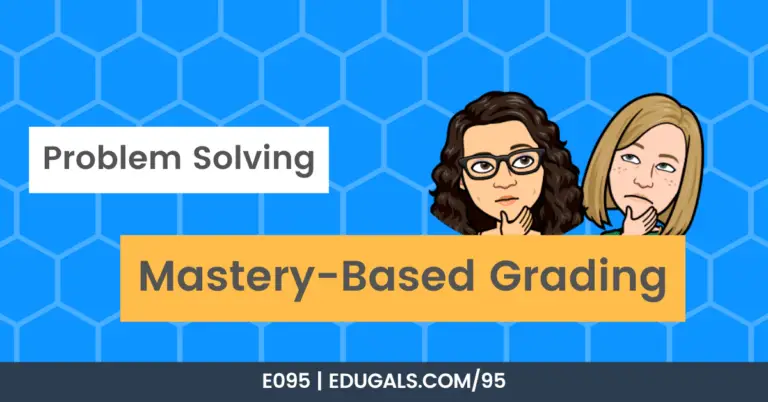Are you wondering why you might not want to use the 100 point grading scale, and what you might want to do instead? There are many reasons why it’s not the best scale to use, and, in this article, we will show you how you can flip that around to make grading more equitable.
We’ve been on a bit of a journey with ungrading. There has been a lot of learning over time, and there are some really great resources that have helped guide us. It’s worth having these conversations because failures and zeros have a huge impact on our students’ success, and really don’t reflect their learning.
Interested in listening to our conversation on rethinking your grading scale? We’ve created a podcast episode to go along with this topic below!
Probably one of the best resources that we’ve come across that talks about different grading practices that are essentially bias-resistant and equitable for students is “Grading for Equity” by Joe Feldman. This is an excellent book, and really gets into the different issues around grades and grading. He explains it in a way that is easy to understand, and is quite logical. So if you’re wondering where to start with some of this learning, this resource is definitely it!
What is wrong with the 100 point scale?
This scale, which is giving a student a percentage grade from 0 – 100 is something that is inherent in all of our education systems. It’s everywhere, and it’s not something that you can escape necessarily, because we still have to create a mark out of 100. That being said, there are workarounds and things that you can do to help it more accurately reflect student learning.
That being said, let’s get back to what’s wrong with it! First a foremost, this type of scale is biased towards failure. Half of the scale, so 0-49%, are considered failure (even more if you’re in an area where failure is 0-59%). This means only 50 marks, or 40 in areas where a pass is 60%, are considered a pass.
Why do we have such a large range of failing marks?! Why provide such a large scale for failure?!
Now consider what happens when you give a student a zero. It can be so challenging for that student to then overcome that grade in order to recover from that. It disproportionately punishes the students.
At times, it may make sense to use a zero, particularly around reporting times, but it doesn’t have to be every single zero. If we are using it when students have not completed anything at all, that’s one thing, but we need to be looking at overall learning, and not punishing students unnecessarily.
Another reason why the 100 point scale is not great is because there are too many transition points between grades for a teacher to be able to make any sort of good judgment on student work. For example, it is extremely difficult to judge the difference between an 88% and an 87%. There are so many transition points that it becomes difficult to define the criteria for one over another.
And the difference in an 88% assignment vs an 87% would be nearly impossible to discern, which is a big issue!
There’s also an issue with consistency in marking across grade teams. What one teacher may grade as 90%, another may grade as 70%, another as 80%, etc. Without clearly defined criteria, it is difficult to have consistency in marking across course teams.
The 4-level grading system
Here in Ontario we have the level system. It is essentially a five-point grading system; Levels 4, 3, 2, 1, and R for students that are not meeting at least the minimum passing criteria. This is a better system than the 100-point scale, but there’s definitely still room for improvement.
One thing we tend to do as teachers is to provide quizzes are we are teaching (marked, of course), do more activities that are also marked, and then a final unit test or project that is also marked. A part of us questions why on earth we are marking each and every one of these things?!
As a teacher, if you notice a student is struggling at the beginning through a quiz, you would then address that with the students, and help them to learn so that by the end they are demonstrating their learning more consistently and effectively – so why don’t we take that mark at the end as the grade, instead of all the steps in between.
We are supposed to mark for overall learning expectations by the end of a unit, so why also mark and provide grades for the formative assessment that helps guide educators in determining supports that are needed, what gaps need to be addressed, etc.?
Why not look at most recent, and most consistent when assigning grades? In a course that is skills-based, it makes sense to exclude early assessments, especially since the skills typically build throughout the semester and the students will be demonstrating these skills in different ways throughout the course.
So if not a 100 point scale, what do we use?
As we touched upon earlier, a scale with fewer points is the ideal way to go. It doesn’t have to be a five point scale; it could be a three point scale, two point scale, or even a one point scale. It really depends on how many transition points you want between the different grades, and how you want to be able to discern between the different levels.
The reason we like these minimum scales is because it’s a lot easier to see the different between student achievement, ie. whether a student is a level four versus a level three, etc. You can more clearly see the differences.
Katie likes using single-point rubrics. The success criteria is a checklist, which aligns with a level 3 in Ontario. If a student doesn’t complete all of the criteria, they are not a level 3. Even from here, the difference between a level 4 and a level 3 are quite obvious.
Rachel, on the other hand, has gone the opposite – she creates something similar to a one-point scale, but provides criteria that lists out exactly what a level 4 vs 3 vs 2 vs 1 looks like. She allows her students to have three attempts to demonstrate mastery on a particular assignment or task. It gives students a chance to go back, work on it, and further improve their learning. Check out our episode on specifications grading to learn more!
It really is a matter of trying out different scales and seeing what works best for you. What has worked well, though, is that students react well when the success criteria is laid out so simply and clearly. There are no guessing games, and no rubric eduspeak that can be difficult to understand.
You may find that there is some resistance to different scales or allowing multiple attempts on tasks. Some people may think that it’s watering down the curriculum or the expectations, but really, it’s quite the opposite! We are raising the expectations! We want students to actually master a skill and demonstrate their learning at a higher level before they move on – this is a positive thing when we think about student learning in a course!
If 80% is considered mastery in a class, it may take students multiple attempts to develop the skills in order to get there. Achievement will increase as learning increases – but is that a bad thing?!
Katie teaches ESL. In her class, students have opportunities to demonstrate specific skills multiple times. Knowing this, she provides feedback to students on tasks, and allows them to resubmit a task that has the same language skills to replace that mark. It works well for a language class, but it may not work well in other content areas.
Not yet ready to ditch the 100-point scale? Try these suggestions!
Getting rid of the 100-point scale may seem scary, or maybe you just aren’t ready, and that’s okay. If you want to try some small changes, here are some easy-to-implement changes:
- Set a minimum grade
- Eg. 40% as the minimum possible grade for an attempt (if 50% is a pass);
- This helps level out the marks so that there’s ten points between each mark band or letter grade. It won’t impact the grade quite as much, and it gives students the motivation to still engage and try their best in your course.
- Consider using specific grades within the 100-point scale
- Instead of using every single number, use a few grade points per 10% – for example: 72%, 75%, 78% can be the three grade points within the 70s, then extend that to the other ranges as well;
- This creates consistency, especially since we know that the difference between a 77% and a 78% is extremely difficult to determine
These are all very difficult conversations to have, and it can be really uncomfortable to consider changing the way we grade. But it’s important to sit in your discomfort and ask yourself why you are uncomfortable. Much like equity work, we need to question our emotional responses and why we are feeling a certain way. Why are we defensive? What are we uncomfortable?
Does a zero really mean that a student has zero comprehension of a skill or topic, or does it mean that they have zero compliance? It’s for this reason that we argue a minimum grade should be used. Oftentimes, what we are seeing in work that we deem unsuccessful is a lack of compliance.
If you see that skill demonstrated in class, but they don’t show compliance on an assignment, is that zero still appropriate? Perhaps a 40% is more appropriate than a zero, which could be the result of many different factors. That learning that you have seen in class should still have value.
Okay, so I’ve used a different scale, how do I get back to a grade for reporting?!
One last thing we should discuss is how to translate this all back into a grade for the purpose of reporting. We all know that at the end of the day we need to input a mark for midterm and final reporting, and that grade has to be out of 100. We’ve talked so much about changing our scales, so now what do you do with it?!
If you are using a gradebook like ours (which really isn’t great, but it works), then the nice thing is that there is a level option when inputting marks. The levels are 1 through 4, with the ability to input a range within that level (example: 3-, 3, 3+) and it converts it to a numerical mark.
Another option is to use conferencing with students. Since students are aware of their level, you could then sit down with them and conference to come up with a grade together. It’s take more time, but it lets students think about the role that they have in their grades, which is important. This could be done hand-in-hand with a reflection where students have thought about examples of how they’ve demonstrated skills, and what they think that they should get in terms of marks. This is a great way to get students to buy-in and take ownership of their learning.
Another option? Most recent, most consistent! You could look at how students have performed throughout the unit or course, and determine if there is a trend in progress or improving their skills. If they have demonstrated that learning more successfully over time, then it’s worth considering using that mark versus the lower marks.
At the end of the day, it isn’t about making big, drastic changes all at once. It’s really about taking the time to think about your grading practices, and to see where there’s room to change or improve, one small step at a time.





